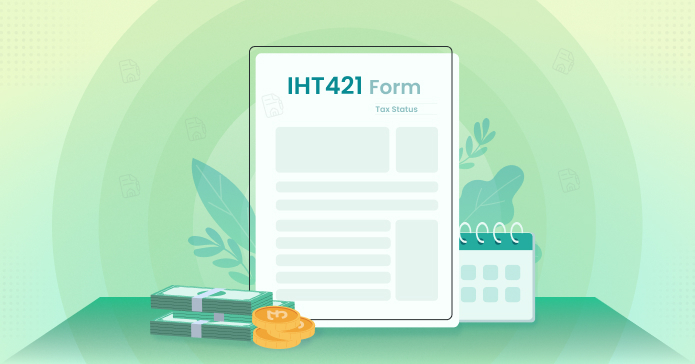Inheritance tax (IHT) can be a daunting subject, especially when dealing with an estate after a loved one’s passing. If you’re navigating probate or estate administration in the United Kingdom, you’ve likely come across references to the IHT421 form. But what is it, and why is it crucial during this process?
This blog will break down everything you need to know about the IHT421 form, its relationship with inheritance tax, and the steps you need to take to manage your estate responsibilities effectively.
What Is the IHT421 Form?
The IHT421 form, often referred to as the “probate clearance form,” is a document issued by HM Revenue & Customs (HMRC). It serves as confirmation that all inheritance tax (IHT) owed on an estate has been calculated or paid. Without completing this form, probate cannot be granted, as HMRC must confirm that the tax position of the estate is resolved.
Here’s why the IHT421 form matters:
- Tax Clearance: It verifies that the inheritance tax due on the estate has been paid or that no tax is owed.
- Probate Requirement: It gives HMRC the green light to notify the probate registry, enabling the executor to obtain the legal authority (known as a Grant of Probate) to administer the estate.
- Streamlined Estate Settlement: Submitting this form ensures the process of distributing the deceased’s assets can proceed without unnecessary delays.
For estates below the inheritance tax threshold (£325,000 as of 2024), an IHT421 form is still needed, but it will reflect that no tax is due.
Understanding UK Inheritance Tax (IHT)
What Is It?
Inheritance tax is levied on the estate of someone who has died, including properties, money, and possessions. The standard tax rate is 40% and only applies to the portion of the estate exceeding the nil-rate band threshold, currently £325,000.
Key Points to Know About IHT
- Any inheritance left to a spouse or civil partner is typically exempt from IHT.
- The Residence Nil-Rate Band (RNRB) allows an additional threshold of up to £175,000 if the deceased’s residence is left to direct descendants, bringing the total threshold to £500,000.
- Charitable donations, business assets, and other reliefs may further reduce IHT liability.
With rising estate values in the UK, HMRC has increased efforts to ensure compliance, making precision and timely filing more important than ever.
IHT421 Form Requirements
When Is the IHT421 Form Required?
The IHT421 form is mandatory in cases where probate is needed, whether or not the estate owes tax. Common scenarios include:
- Estates exceeding the £325,000 threshold.
- Estates with complex assets like rental properties, stock portfolios, or business interests.
- Even tax-exempt estates still undergo the clearance process to confirm their status with HMRC.
Information Needed for the IHT421 Form
To file the IHT421 form, you’ll need:
- The full name and personal details of the deceased (e.g., date of death, National Insurance number).
- Executor’s or personal representative’s information.
- A breakdown of the estate’s value, liabilities, and exemptions (aligned with other IHT forms like IHT400).
To simplify the process, most executors rely on estate accountants or solicitors to ensure every detail is accounted for.
What Does the Submission Process Look Like?
Once inheritance tax is calculated (or confirmed as not owed), the executor completes and submits the IHT421 form to HMRC. After HMRC reviews the documents, they forward the clearance directly to the probate registry, allowing executors to continue with the probate process.
Note: HMRC generally processes IHT421 forms within 15 working days, though this can vary based on the complexity of the estate.
Is IHT421 No Longer Required?
You may have read that the need for IHT421 has evolved in some regions, like England and Wales, as digital systems streamline the process. However, estates still require confirmation of IHT clearance through some form of documentation or unique reference tied to IHT calculations. For regions such as Northern Ireland, IHT421 remains a required part of probate applications.
Common FAQs About the IHT421 Form
How Much Money Can You Have in the Bank Before Probate in the UK?
This limit generally varies between banks but is typically £5,000–£50,000. Check with individual institutions on their specific threshold for releasing funds without probate.
How Long After Submitting IHT421 Is Probate Granted?
Once the probate registry receives the IHT421 form from HMRC, it typically takes four to eight weeks to process the Grant of Probate, depending on the complexity of the case.
What Has Replaced IHT421?
For simpler estates in England and Wales, HMRC may issue a unique code linked to the IHT calculation, bypassing the need for a standalone IHT421 form. However, this does not universally apply, especially for complex cases or estates in other UK jurisdictions.
Is the IHT421 Form Required for Estates Below the Tax Threshold?
Yes, even if an estate is below £325,000 or fully exempt, the IHT421 form or an alternative clearance is required to confirm eligibility for probate.
Breakdown of an Estate and IHT Tax Calculation
| Estate Value | IHT Due | Tax Paid | IHT421 Submitted | Probate Granted |
| £250,000 | £0 | N/A | Yes | Yes |
| £500,000 | £50,000 | Yes | Yes | Yes |
| £750,000 | £100,000 | No | Pending | No |
This table demonstrates how estates are cleared for probate via IHT421 based on tax obligations.
Key Tips for Executors Using the IHT421 Form
Do:
- Verify Valuations Early: Ensure all properties, financial assets, and debts are properly valued to avoid misfiling.
- Stick to Deadlines: HMRC expects IHT to be paid or arranged within six months of the date of death.
- Seek Assistance: It’s often worth working with accountants or tax advisors, especially for estates near the taxable threshold.
Don’t:
- Overlook Supporting Documents: Double-check bank statements, property valuations, and other records before submission.
- Underestimate Processing Time: Factor in HMRC’s 15-working-day processing time for IHT421 and additional time for probate registry approval.
Why Choose Debitam for IHT Guidance?
Navigating inheritance tax forms like IHT421 requires precision, knowledge, and up-to-date expertise. At Debitam, we specialize in supporting property owners, landlords, and inheritance taxpayers with seamless, stress-free filing services. Whether it’s ensuring accurate IHT calculations or guiding complex estates through probate, our experts are here to help.
Contact us today for tailored advice and professional assistance with your inheritance tax needs.













